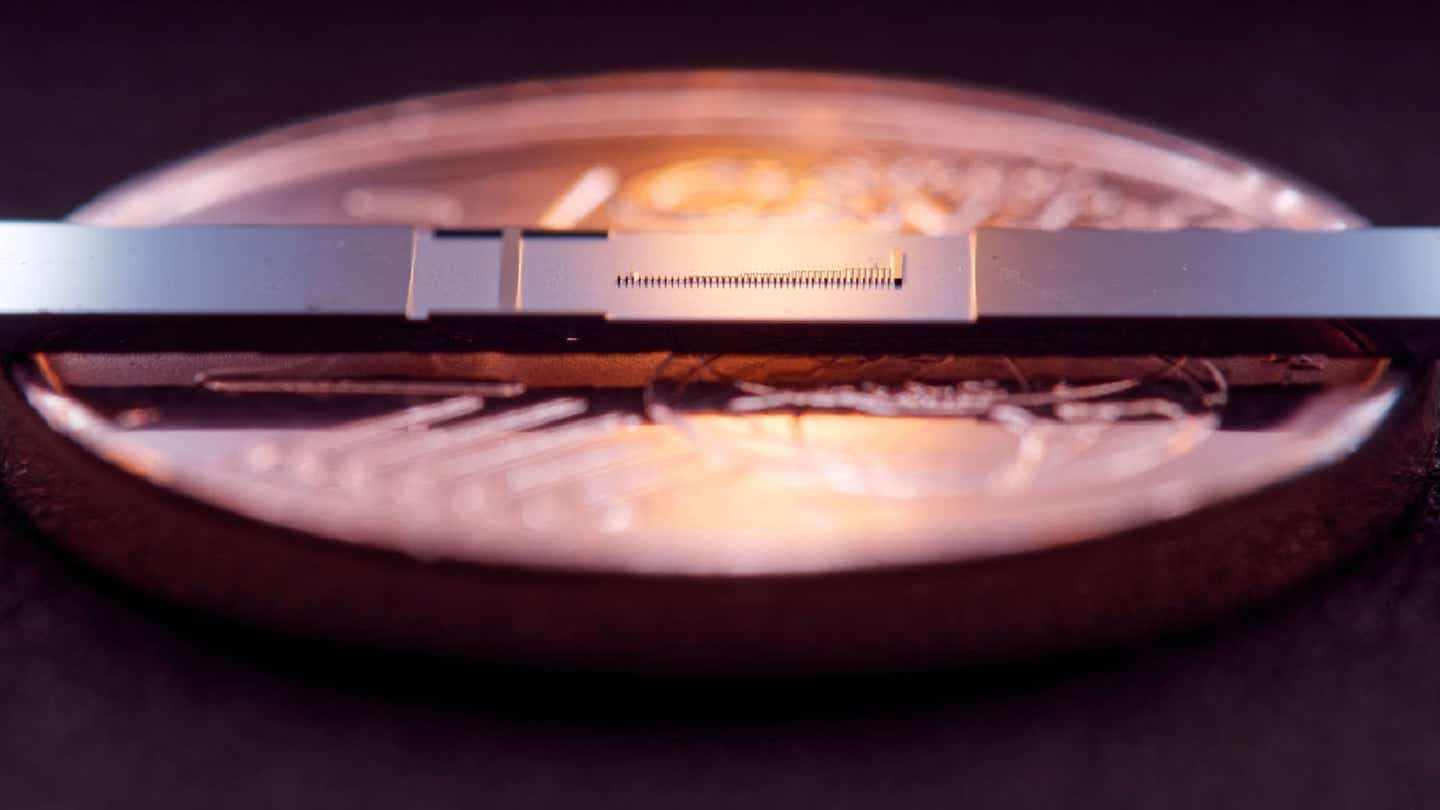World’s smallest particle accelerator is 54 million times smaller than the Large Hadron Collider
The nanophotonic electron accelerator consists of a microchip that houses a tiny acceleration tube that is just millimeters long.

[Oct. 26, 2023: Staff Writer, The Brighter Side of News]
The nanophotonic electron accelerator consists of a microchip that houses a tiny acceleration tube that is just millimeters long. This photo shows the device compared to a dime. (CREDIT: FAU/Laser Physics, Stefanie Kraus, Julian Litzel)
In a groundbreaking scientific advancement, scientists have ignited the world's smallest particle accelerator for the very first time. This technological marvel, astonishingly as small as a coin, promises to usher in a myriad of applications, including potentially revolutionary treatments inside the human body.
The pioneering machine is christened the nanophotonic electron accelerator (NEA). It's essentially a petite microchip that cradles a minuscule vacuum tube composed of thousands of individual "pillars." These pillars play a vital role: when bombarded with tiny laser beams, they facilitate the acceleration of electrons.
To truly grasp the magnitude of this innovation, consider the following scale. The primary acceleration tube of the NEA spans about 0.02 inches (0.5 millimeters) in length. This is astoundingly 54 million times more compact than the colossal 16.8-mile-long (27 kilometers) ring encompassing CERN's Large Hadron Collider (LHC) in Switzerland.
The LHC, recognized as the world's largest and most potent particle accelerator, has an illustrious history, being the discovery ground for numerous particles like the Higgs boson, elusive neutrinos, charm meson, and the enigmatic X particle.
Related Stories
To further provide perspective, the internal diameter of this revolutionary tiny tunnel stands at roughly 225 nanometers. Given that a human hair measures between 80,000 to 100,000 nanometers in thickness, this truly underscores the machine's microscopic scale, as reported by the National Nanotechnology Institute.
In a first-ever study released in the journal Nature, the diligent researchers from the Friedrich–Alexander University of Erlangen–Nuremberg (FAU) in Germany detailed their experiment. Employing the NEA, they accelerated electrons, amplifying their energy from 28.4 kiloelectron volts to 40.7 keV – marking an impressive surge of approximately 43%.
This achievement is a momentous occasion. As per the researchers' statement, it marks the maiden time a nanophotonic electron accelerator – a concept introduced to the world in 2015 – has been fired successfully. Notably, a team from Stanford University has also reportedly replicated this accomplishment, though their findings remain under scholarly scrutiny.
The LHC is 54 million times longer than the vaccum tube of the nanophotonic electron accelerator. (CREDIT: Getty Images)
"For the first time, we really can speak about a particle accelerator on a [micro]chip," proclaimed study co-author Roy Shiloh, a distinguished physicist at FAU.
Contrastingly, the LHC employs over 9,000 magnets, creating a potent magnetic field to accelerate particles, propelling them to nearly 99.9% of light speed. The NEA, on the other hand, also generates a magnetic field. However, its modus operandi is distinct, relying on light beams targeting the pillars within its vacuum tube. This method precisely amplifies energy, albeit yielding a significantly weaker energy field.
Principle of simultaneous acceleration and beam confinement in a nanophotonic structure. (CREDIT: Nature)
When benchmarked against the LHC, the electrons driven by the NEA possess merely about a millionth of the energy. Yet, the undeterred researchers are optimistic about refining the NEA's blueprint. By either leveraging alternative materials or juxtaposing several tubes, they anticipate amplifying particle acceleration. However, they candidly admit that the energy levels achievable with the NEA will not rival those of monumental colliders.
But, therein lies the beauty. The overarching objective behind the birth of these accelerators isn't just raw power. Instead, it's the aspiration to harness the energy emitted by the accelerated electrons for pinpointed medical interventions. This could be a game-changer, potentially offering a safer alternative to the current potent forms of radiotherapy employed in annihilating cancer cells.
Electron energy spectra showing coherent electron acceleration. (CREDIT: Nature)
Dreaming big, study lead author Tomáš Chlouba, another eminent physicist at FAU, envisions a future where a particle accelerator could be integrated into an endoscope. This would pave the way for direct internal radiotherapy, targeting the affected body region with unmatched precision. However, Chlouba injects a note of caution, asserting that such applications might still be on the distant horizon.
While the world's tiniest particle accelerator might be diminutive in stature, its implications are colossal, heralding a new dawn in medical treatments and nanotechnology.
For more discovery news stories check out our Discoveries section at The Brighter Side of News.
Note: Materials provided above by The Brighter Side of News. Content may be edited for style and length.
Like these kind of feel good stories? Get the Brighter Side of News' newsletter.
Joseph Shavit
Head Science News Writer | Communicating Innovation & Discovery
Based in Los Angeles, Joseph Shavit is an accomplished science journalist, head science news writer and co-founder at The Brighter Side of News, where he translates cutting-edge discoveries into compelling stories for a broad audience. With a strong background spanning science, business, product management, media leadership, and entrepreneurship, Joseph brings a unique perspective to science communication. His expertise allows him to uncover the intersection of technological advancements and market potential, shedding light on how groundbreaking research evolves into transformative products and industries.



